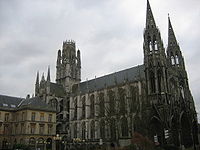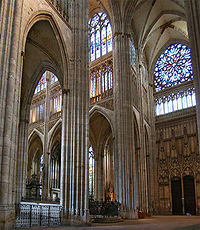- Church of St. Ouen, Rouen
-
The Church of St. Ouen is a large Gothic Roman Catholic church in Rouen, northern France, famous for both its architecture and its large, unaltered Cavaillé-Coll organ, which Charles-Marie Widor described as "a Michelangelo of an organ". Built on a similar scale to nearby Rouen Cathedral, it is, along with church of Saint Maclou, one of the principal Gothic monuments of Rouen.
Contents
The Abbey
The church was originally built as the abbey church of Saint Ouen for the Benedictine Order, beginning in 1318 and interrupted by the Hundred Years' War and sacked and badly damaged during the Harelle. It was completed in the 15th century in the Flamboyant style.
The foundation of St. Ouen's Abbey has been variously credited, among others, to Clothair I and to St. Clothilda, but evidence is scanty. It was dedicated at first to St. Peter when the body of St. Ouen, Archbishop of Rouen (d. 678), was buried there; the name of St. Peter and St. Ouen became common and finally St. Ouen only. The history of the abbey, on record from the 1000, is unremarkable; a list of abbots is in Gallia Christiana XI, 140. In 1660 the monastery was united to the Congregation of St. Maur, and when suppressed, in 1794, the community numbered twenty-four. The abbey building itself was vacated by the time of the French Revolution and was subsequently occupied by the Town Hall of Rouen.[1]
Architecture
The church is 137 m long under 33 m high vaults. The central crossing is surmounted by an unusual lantern-style tower similar to that at Ely Cathedral in England. The tower was done in the Flamboyant style. The well-preserved stained glass is predominantly from the 14th century, featuring jewel tones among panels of clear and frosted white glass, and leading to a brighter interior than is usual with Gothic churches. The hitherto unfinished façade was completed between 1846 and 1851.
Organ
The basilica contains a large four-manual pipe organ built in 1890 by Aristide Cavaillé-Coll. This instrument is considered to be one of the most important organs in France, and is notable for its unusually powerful 32' Contre Bombarde. The organ stands unaltered and thus is one of the few of the master's works to speak with its original voice.
I Positif Montre 8’ Bourdon 8’ Gambe 8’ Unda maris 8’ Flûte douce 4’ Dulciane 4’ Doublette 2’ Plein-jeu V 1’ Cor anglais 16’ Trompette 8’ Cromorne 8’ Clairon 4’ II Grand-Orgue Montre 16’ Violonbasse 16’ Bourdon 16’ Montre 8’ Diapason 8’ Bourdon 8’ Salicional 8’ Flûte harmonique 8’ Prestant 4’ Trompette en chamade 8’ Clairon en chamade 4’ III Récit expressif Quintaton 16’ Corno dolce 16’ Diapason 8’ Flûte traversière 8’ Cor de nuit 8’ Voix éolienne 8’ Viole de gambe 8’ Voix céleste 8’ Flûte octaviante 4’ Viole d’amour 4’ Quinte 2 2/3’ Octavin 2’ Carillon I-III 1’ Cornet V 8’ Tuba magna 16’ Trompette harmonique 8’ Basson-Hautbois 8’ Clarinette 8’ Voix humaine 8’ Clairon harmonique 4’ Tremolo IV Bombarde Flûte 8’ Flûte 4’ Doublette 2’ Cornet V (III ?) 16’ Fourniture V 2 2/3’ Bombarde 16’ Basson 16’ Trompette 8’ Clairon 4’ Pédale Soubasse 32’ Contrebasse 16’ Soubasse 16’ Basse 8’ Violoncelle 8’ Bourdon 8’ Flûte 4’ Contre Bombarde 32’ Bombarde 16’ Basson 16’ Trompette 8’ Clairon 4’ - Couplers: Tirasse G.O., Tirasse Pos., Tirasse Réc., Appel G.O., Pos./G.O., Réc./G.O., Bomb./G.O., Pos./Réc., Bomb./Réc., Oct. gr. G.O., Oct. gr. Réc./G.O., Oct. gr. Réc., Oct. aiguë Réc., Anches Péd., Anches G.O., Anches Pos., Anches Réc., Anches Bomb., Trémolo Réc., Expression Réc., Orage
Notes
External links
Categories:- 14th-century architecture
- 15th-century architecture
- 19th-century architecture
- Benedictine monasteries in France
- Pipe organs
- Gothic architecture in France
- Buildings and structures in Rouen
Wikimedia Foundation. 2010.




